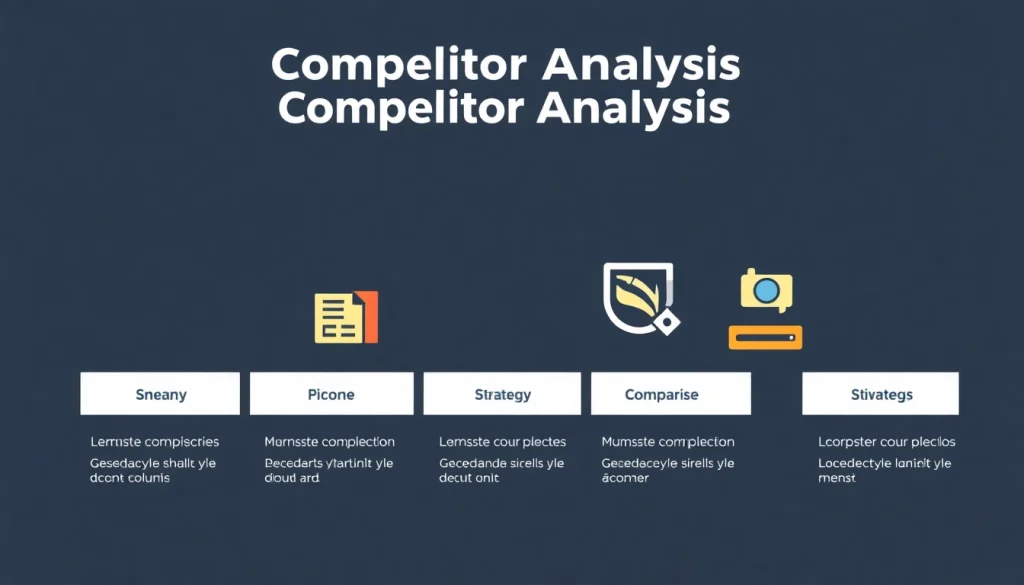Understanding Competitor Analysis
What is Competitor Analysis?
In today’s competitive marketplace, businesses must constantly evaluate their performance and strategies against their rivals. Competitor analysis, also known as competitive analysis or competition analysis, is the process of examining similar brands within your industry. This examination is intended to gain insights into their offerings, branding practices, sales strategies, and marketing approaches. By understanding how competitors operate, businesses can identify opportunities for improvement and ways to differentiate themselves in the marketplace.
The Importance of Competitor Analysis
Competitor analysis is crucial for several reasons:
- Strategic Positioning: By understanding competitors, you can better position yourself within the market to attract customers.
- Identifying Trends: Analyzing your rivals can provide insights into emerging market trends that could influence your business approach.
- Benchmarking Success: Competitor performance metrics serve as benchmarks against which you can evaluate your company’s progress.
- Avoiding Blind Spots: Understanding competitor weaknesses helps you avoid similar pitfalls in your business strategy.
- Innovation Inspiration: Observing how competitors innovate can inspire your paths of development.
Common Misconceptions about Competitor Analysis
Despite its benefits, many businesses harbor misconceptions about competitor analysis:
- It’s Just About Price: Competitor analysis is not solely focused on pricing strategies; it encompasses a variety of aspects including product features and marketing tactics.
- Only for Large Companies: Small businesses can benefit significantly from competitor analysis, just as much as their larger counterparts.
- It’s a One-Time Activity: Competitor analysis should be an ongoing process as market dynamics continuously evolve.
Identifying Your Competitors
Direct vs. Indirect Competitors
To conduct an effective competitor analysis, you first need to identify your competitors. These can typically be categorized into two types:
- Direct Competitors: These are businesses that offer the same products or services as you, targeting the same audience. For example, two coffee shops in the same neighborhood serve the same customer base.
- Indirect Competitors: These businesses offer alternative products or services that can satisfy the same customer need. For instance, a tea shop might be considered an indirect competitor to a coffee shop.
Using Tools to Identify Competitors
Various tools and online resources can assist you in identifying your competitors:
- Google Search: A simple search can reveal competitors by examining search results for your keywords.
- Social Media Platforms: Sites like Facebook and Instagram can help identify brands within your niche.
- SEO Tools: Platforms like SEMrush, Moz, or SimilarWeb can provide insights into competing websites, their traffic, and their keyword strategies.
Assessing Competitors’ Market Position
Once you’ve identified your competitors, understanding their market position is essential. This involves looking at aspects such as:
- Market Share: Assess how much of the market your competitors control.
- Brand Reputation: Investigate customer sentiment surrounding your competitors through reviews and social media mentions.
- Product Offerings: Analyze the range and quality of products or services offered by your competitors and how they differ from your own.
Collecting Data
Websites and Online Presence
Your competitors’ websites are a treasure trove of information. Focus on the following elements:
- Design and User Experience: Evaluate the usability, accessibility, and overall design of competitors’ websites.
- Content Quality: Analyze the quality and relevance of the content published on their sites.
- Call to Action: Observe the effectiveness of their calls to action (CTAs) and how well they convert visitors into customers.
Social Media Engagement
Understanding how competitors engage with their audience on social media can provide valuable insights:
- Post Frequency: Analyze how often they post content and what types of content generate the most engagement.
- Response Strategies: Look at how quickly and effectively they respond to customer inquiries and comments.
- Follower Engagement: Assess the level of engagement their posts receive through likes, shares, and comments.
Customer Reviews and Feedback
Customer reviews are invaluable for understanding competitor strengths and weaknesses:
- Platforms to Monitor: Regularly check sites like Yelp, Google Reviews, and social media for customer feedback.
- Common Complaints: Identify recurring issues or praises in customer reviews and how your competitors address them.
- Utilizing Feedback: Consider how you can leverage customer feedback to improve your offerings or service quality.
Analyzing Competitor Strengths and Weaknesses
SWOT Analysis Framework
A powerful way to evaluate your competitors is through a SWOT analysis, which involves examining their:
- Strengths: What advantages do they have over competitors?
- Weaknesses: Where do they fall short?
- Opportunities: Are there emerging trends they can exploit?
- Threats: What external factors could harm their business?
Comparing these aspects against your own business can highlight areas for strategic improvement.
Performance Metrics to Consider
When analyzing competitors, consider focusing on specific performance metrics:
- Sales Figures: Where possible, estimate their sales volume to gauge financial health.
- Traffic Metrics: Use tools like SimilarWeb to assess their website traffic and sources of traffic.
- Conversion Rates: While more challenging to determine, understanding how well they convert visitors into customers can indicate their effectiveness.
Benchmarking against Competitors
Benchmarking involves comparing your business against competitors to set performance standards. This can include:
- Pricing Strategies: How do your pricing models compare?
- Service Levels: What customer service metrics can you compare?
- Product Comparisons: Analyze how your products stack up against competitors in quality and features.
Developing Your Competitive Strategy
Identifying Gaps in the Market
Finding gaps in the market can provide opportunities for you to innovate. Consider:
- Customer Needs: What are customers requesting that they aren’t currently getting from competitors?
- Product Features: Are there features or services that your competitors are lacking?
- Geographic Gaps: Are there geographical markets that are underserved?
Adapting Your Marketing Tactics
Your findings should inform your marketing tactics. This might involve:
- Refining Target Audience: Adjust your target demographic based on gaps and insights from analysis.
- SEO Improvements: Use keywords and topics that resonate better than what your competitors are utilizing.
- Content Marketing Strategies: Develop content that directly addresses competitor weaknesses and customer needs.
Monitoring Competitor Activities
Competitor analysis is not a one-time task. To remain competitive, continuously monitor:
- New Product Launches: Keep track of any new introductions from competitors.
- Changes in Marketing Strategy: Note any shifts in how they position themselves in the market.
- Customer Reactions: Remain alert to how the market responds to competitors’ modifications.


